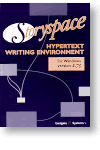Storyspace 3 for macOS
Storyspace – the pioneering hypertext environment – enters a new era with Storyspace 3

Storyspace is a tool for complex, interlinked narrative, both fiction and nonfiction. Twenty years ago, the original Storyspace ushered in the era of serious interactive writing with works like Michael Joyce’s afternoon, a story (“a graceful and provocative work ... utterly essential to an understanding of this new art form” – Robert Coover, NY Times Book Review) and Shelley Jackson’s Patchwork Girl (“A cult hit” – The Village Voice). Now, Storyspace has been updated, extended, and reconceived using fresh technology and design.
Storyspace 3 works with existing Storyspace files and creates new Storyspace documents in a robust, state-of-the-art XML format. Legacy Storyspace work immediately takes advantage of Storyspace 3’s outstanding new typography.
Storyspace 3 works seamlessly with Tinderbox, with which it shares files. Tinderbox is designed for making, visualizing, and analyzing notes, making it ideal for the early stages of ambitious projects. Storyspace is designed for writing and reading interlinked narrative; many writers will move freely between Tinderbox and Storyspace.
Hypertext Narrative
Storyspace 3 is a tool for writing and reading hypertext narrative, for fictional and nonfictional stories told with links. Long the tool of choice for serious hypertext writers, Storyspace now offers new features, new tools, and unmatched elegance for handling complex stories with ease.
From the earliest experimental hypertexts, writers have learned that simply linking pages together isn’t enough. What works in small web sites leaves readers wandering and adrift in book-length environments. Storyspace solved the problem back in the 1990s with guard fields that activate and disable links as the reader moves through the document.
Storyspace 3 supports classic Storyspace guard fields and extends them with a new, easy-to-learn syntax that adds lots of power and flexibility. You can mix old and new guard fields freely.
Sculptural Hypertext
Familiar hypertext tools support calligraphic hypertext, hypertext that begins without links and lets the writer link things that should be connected. Storyspace 3 adds sculptural hypertext tools as well. Sculptural hypertext begins with densely linked bundles like decks of cards, from which the reader might select pages in any sequence. But Storyspace hypertexts aren’t just random: writers can remove links and enforce constraints so the hypertext organizes itself. Sculptural hypertext encourages painterly narrative in which the writer controls what she knows to be necessary while relaxing control over the reader when control might not be needed.
Storyspace
Storyspace 3 is a hypertext writing environment that is especially well suited to large, complex, and challenging hypertexts. Storyspace focuses on the process of writing, making it easy and pleasant to link, revise, and reorganize.
Storyspace 3 is available for Macintosh computers and runs on macOS Catalina, High Sierra, and other recent operating systems.
Storyspace creates hypertexts that you are free to publish and redistribute. A redistributable stand-alone reader is included. Additional reading environments for the Web and for Windows are anticipated as well.

Storyspace excels at creating rich hypertext structures. The unique and powerful Storyspace map shows each hypertext writing space and each of its links. Because writers can add, link, and reorganize by moving writing spaces on the map, Storyspace encourages creative exploration and flexibility.
Storyspace is best known as the tool of choice for serious hypertext writers. Because Storyspace is easy to use, and because it helps writers to visualize and manipulate their work, Storyspace is also popular in writing courses and workshops throughout the world.
Storyspace Case Studies
Storyspace on the Big Screen by Adrian Miles
An Australian educator discusses the role of Storyspace in film criticism.
Storyspace In China by Maris Boyd Gillette
An anthropological team from Harvard uses Storyspace in the field, to study the customs of the Han Chinese.
Storyspace in the Classroom, by Jeanie Crane
A courseware review, reprinted from Computers In The Humanities.
Storyspace in the Language Laboratory, by George Mitrevski
Storyspace is found to be "extremely useful for developing reading materials for foreign language learners."
Documenting Government Procedures on the Web: Storyspace and the Decision Process Guidebook
Technical writers at the U. S. Bureau of Reclamation, a government agency, use Storyspace to design powerful online documentation with rich and effective linking.
Storyspace versus the 'Database of Doom': customer support in the insurance industry, by David Caruba
Storyspace fills a void in providing flexible data access for internal support personnel.
Storyspace and New Media, by Gloria Stern.
Storyspace makes an effective tool for planning and storyboarding.
The Loom and the Weaver: Storyspace and Literary Research, by Dene Grigar and Mindi Corwin.
Two scholars use Storyspace to study the changing portrayal of women by studying Homeric translation through the ages.
Storyspace and Hypervideo Screenwriting: the HyperCafe project.
A profile of Storyspace as a tool for interactive screenwriting, by the winners of the first Engelbart Prize.
Much of the best-known hypertext fiction that has appeared to date was written using Storyspace, starting with Michael Joyce's pioneering classic, afternoon, a story. Eastgate publishes an extensive catalog of fine, original hypertext, both fiction and nonfiction.
Questions for Eastgate?
Questions about Storyspace, or about any Eastgate publication: From the USA or Canada, call Eastgate Systems at (800) 562-1638. From overseas, call +1 (617) 924-9044. From anywhere, e-mail us at orders@eastgate.com.

More ordering information:
You can also write, call, fax, or email Eastgate with questions, or to order.
We accept Visa, MasterCard, American Express, personal and corporate checks, and academic purchase orders. Prices subject to change without notice